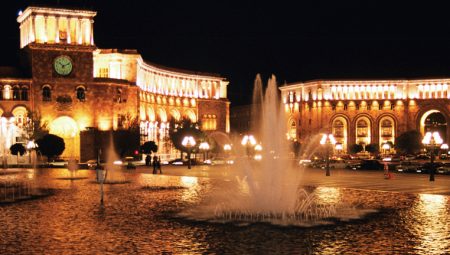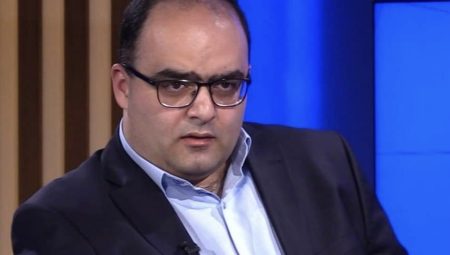The Armenian Apostolic Church and the Armenian government don’t get along. They practically don’t even speak to each other.
The rift between the country’s key institutions has been widening since Armenia’s defeat in the Second Karabakh War in 2020.
And as Armenia pursues a comprehensive peace agreement with neighbor and rival Azerbaijan, the Church is breaking with past tradition and making bold political demands including for the prime minister’s resignation.
Senior Church figures are accusing the government of surrendering the country’s national interests in the talks and are openly siding with the opposition.
The authorities have responded by accusing the clergy of meddling in the governance of the secular state and mused about taxing some of the Church’s property.
Church condemns PM’s position on Karabakh
“Currently there is no relationship as such between the church and the government. It simply does not exist. For the church, the approach of the authorities to resolving the conflict, which boils down to recognizing Artsakh [Nagorno-Karabakh] as part of Azerbaijan, is unacceptable,” Bishop Bagrat Galstanyan, head of the Tavush Diocese of the Armenian Church, told Eurasianet.
His remark echoed a statement issued by the Supreme Spiritual Council of the Armenian Apostolic Church on May 23, the day after Prime Minister Nikol Pashinyan said Armenia was ready to recognize Nagorno-Karabakh as part of Azerbaijan in exchange for security guarantees for the region’s Armenian population.
In April the head of the Church, Catholicos of All Armenians Karekin II (aka Garegin II), said the government and clergy had had only “protocol relations” for some time.
And many have noticed that the prime minister and senior members of his government have been absent from major church events, such as the Christmas liturgy, since at least 2021. Earlier, the political elite occupied a prominent place at such ceremonies.
Seeds of mistrust
The conflict between the Church and government dates back to the beginning, when Pashinyan and his allies came to power following a wave of street protests in 2018.
The “velvet revolution” swept away the old guard that had ruled the country for two decades and had enjoyed good relations with the Church.
For a brief moment, it seemed the revolutionary fervor might bring down the country’s ecclesiastical elite as well.
A group of disaffected priests launched a campaign under the slogan “New Armenia – New Patriarch” which demanded the ouster of the head of the church, Catholicos Karekin II, and a number of bishops for their alleged involvement in the former government’s corrupt ways.
At the time the new authorities distanced themselves from the uprising in the Church, which ultimately failed. Many established clerics were convinced that Pashinyan was out to get them, however.
Political scientist Hrant Mikaelyan agrees. Moving against the church would have been in line with the revolutionary authorities’ fight with the broader entrenched establishment in Armenia, he told Eurasianet.
“He [Pashinyan] consistently subjugated the government, then the parliament, then the courts and wanted to make a revolution against the church, which did not work,” Mikaleyan said, citing as evidence the fact that one of the leaders of the would-be Church insurrectionists was appointed as rector of Gyumri University.
Later, Armenia’s defeat in the 2020 Second Karabakh War with Pashinyan as commander-in-chief created an opening for his opponents, who include politicians associated with the old regime and distrustful clerics.
A month after the war’s end, the Church joined the opposition’s call for Pashinyan’s resignation. Relations between the country’s leading political and spiritual institutions reached their lowest level in the country’s three-decade history. While Armenia is a secular state, its constitution recognizes the “exclusive mission of the Armenian Apostolic Church as the national church in the spiritual life of the Armenian people.”
Spat intensifies
The Church and the government have exchanged sharp barbs over the past few months in particular.
In April, Karekin II, the catholicos, took umbrage at Pashinyan’s earlier remark that “there are clergymen in our country who do not believe in God.”
“A person who does not believe in God cannot be a clergyman,” the top cleric said.
Pashinyan then doubled down, saying, “If the relationship between the Church and the government is not good, then the Church does not have a good relationship with God.”
The prime minister also clearly puts little stock in Karekin II’s assertion that “the Church is not involved in political processes” and is ready for dialogue with political leaders on “pressing issues.”
In May, the prime minister invited the Church to officially enter the political fray.
“If the church wants to carry out political activities, Armenia is a democratic country, and it is possible to carry out political activities. Nothing is stopping them from creating a party and launching political activities within this party. This would be more honest: they will be on the same plane with voters and political rivals,” he said at a meeting with schoolchildren.
He also suggested that the paraffin the Church imports for making candles could be subjected to the customs duties it is currently exempt from because of its status as a charity item.
Also in May, the government removed the teaching of “the History of the Armenian Church” as a separate subject from the public school curriculum. Karekin II called that decision “short-sighted”. He invited the authorities to discuss the issue with Chruch representatives but was rebuffed.
Church authority grows
Political analyst Hrant Mikaelyan believes that the Church currently has the upper hand in the rivalry, particularly since the government explicitly stated its willingness to recognize Azerbaijani rule over Karabakh.
He cited a recent poll that found a narrow majority of Armenians with a positive view of the Church, contrasted with a 14 percent approval rating for Prime Minister Pashinyan (it should be pointed out in fairness that no individual politician had a higher rating).
“In this situation, Pashinyan does not have the power to delegitimize the church,” Mikaelyan said.
Stepan Danielyan, an analyst and scholar of relations between religious and secular authorities, concurs.
“Until 2018, I was one of the critics of the church, because it was merged with the authorities. Now the paths of the church and the authorities have diverged, which can be welcomed. This led to the growth of the authority of the church. And this happened for the reason that earlier led to the fall of its authority. Now, the church is perceived as a completely sovereign institution, one that echoes the concerns of the public and one does not share responsibility for the authorities’ mistakes,” Danielyan told Eurasianet.
Arshaluis Mgdesyan
https://eurasianet.org/rift-widens-between-armenian-church-government





